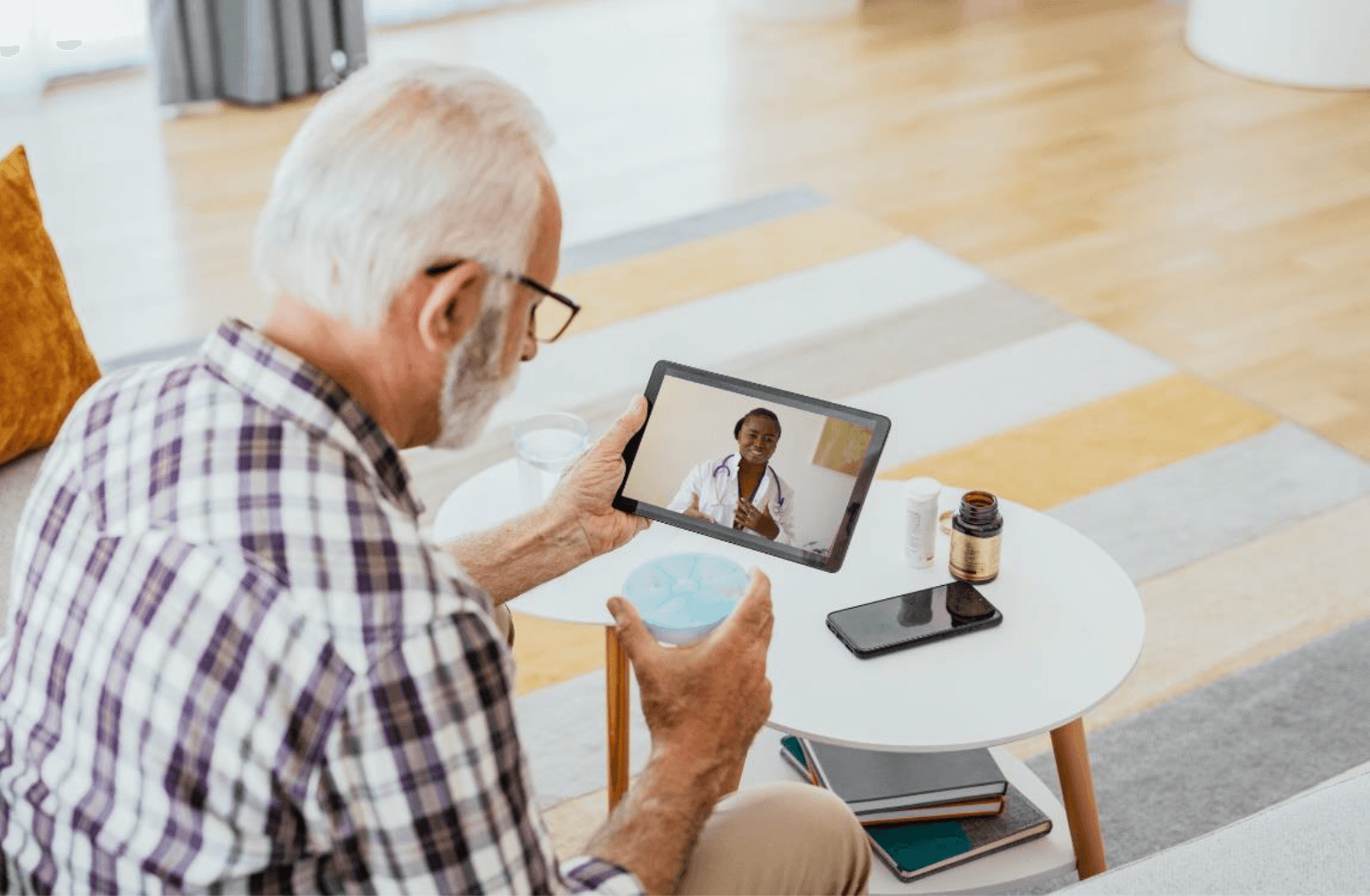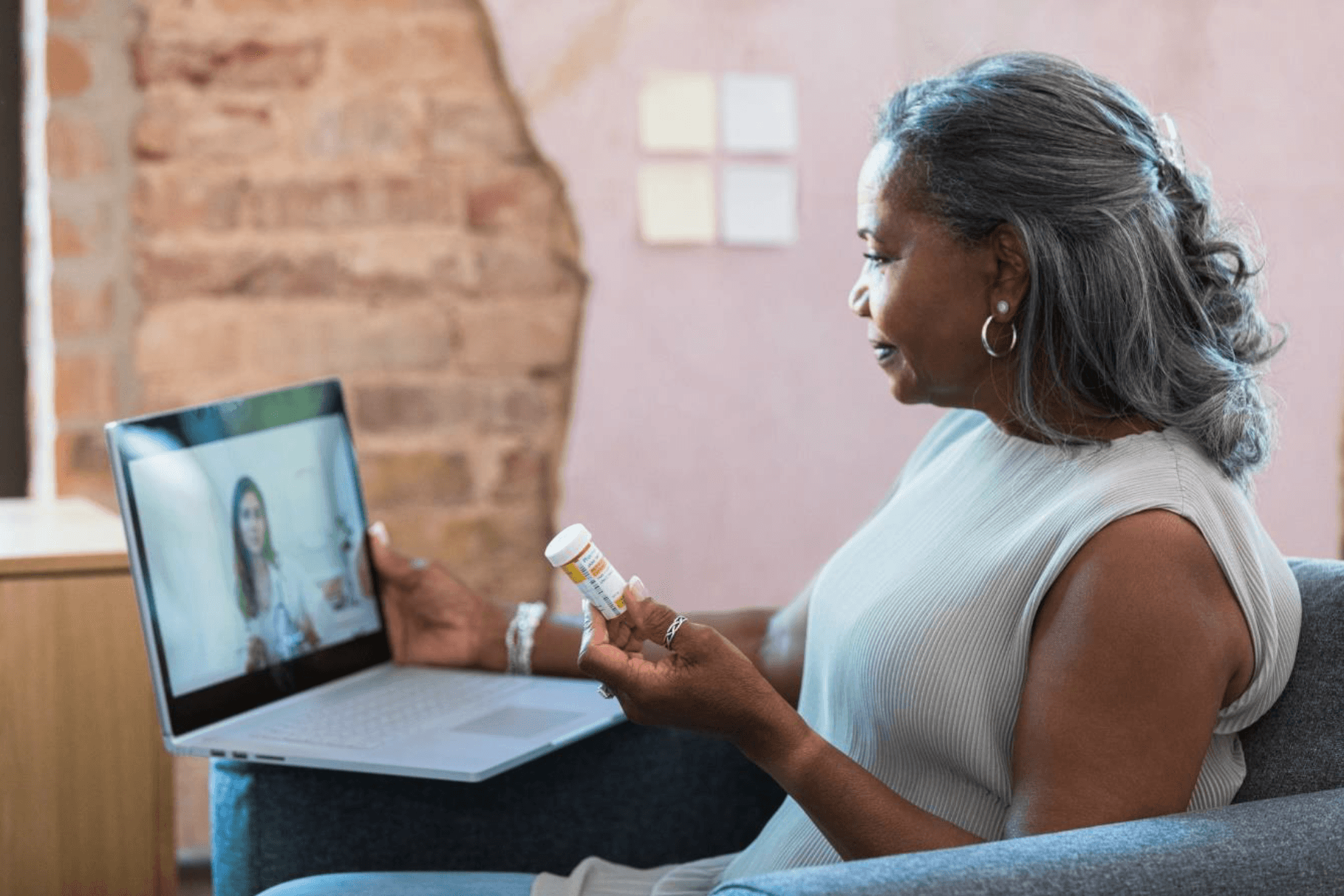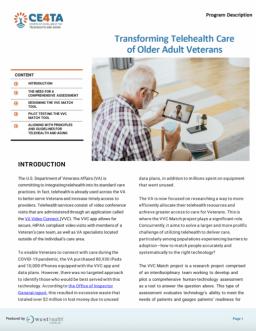Transforming Telehealth Care of Older Adult Veterans
Program description highlighting how the U.S. Department of Veterans Affairs is helping Veterans access care through their Video Connect app and piloting a project to implement an assessment tool that assesses technology's suitability for patients' needs, readiness for telehealth visits, and support for improving healthcare delivery for older adults.
January 30, 2024CONTENT
INTRODUCTION
THE NEED FOR A COMPREHENSIVE ASSESSMENT
DESIGNING THE VVC MATCH TOOL
PILOT TESTING THE VVC MATCH TOOL
ALIGNING WITH PRINCIPLES AND GUIDELINES FOR TELEHEALTH AND AGING

INTRODUCTION
The U.S. Department of Veterans Affairs (VA) is committing to integrating telehealth into its standard care practices. In fact, telehealth is already used across the VA to better serve Veterans and increase timely access to providers. Telehealth services consist of video conference visits that are administered through an application called the VA Video Connect (VVC). The VVC app allows for secure, HIPAA compliant video visits with members of a Veteran’s care team, as well as VA specialists located outside of the individual’s care area.
To enable Veterans to connect with care during the COVID-19 pandemic, the VA purchased 80,930 iPads and 10,000 iPhones equipped with the VVC app and data plans. However, there was no targeted approach to identify those who would be best served with this technology. According to the Office of Inspector General report, this resulted in excessive waste that totaled over $2 million in lost money due to unused data plans, in addition to millions spent on equipment that went unused.
The VA is now focused on researching a way to more efficiently allocate their telehealth resources and achieve greater access to care for Veterans. This is where the VVC Match project plays a significant role. Concurrently, it aims to solve a larger and more prolific challenge of utilizing telehealth to deliver care, particularly among populations experiencing barriers to adoption—how to match people accurately and systematically to the right technology?
The VVC Match project is a research project comprised of an interdisciplinary team working to develop and pilot a comprehensive human-technology assessment as a tool to answer the question above. This type of assessment evaluates technology’s ability to meet the needs of patients and gauges patients’ readiness for telehealth visits, while also identifying the necessary support to help patients prepare for a successful telehealth visit. The assessment was developed by Dr. Julie Faieta, a licensed occupational therapist who holds a PhD in Health and Rehabilitation Sciences. Her research has focused on digital health design and informed implementation of technology tools to advance healthcare delivery for older adults.
THE NEED FOR A COMPREHENSIVE ASSESSMENT
Dr. Faieta realized early on in her career that providing patients with access to technology—especially older adults who may experience impactful barriers to telehealth like physical and/or cognitive impairments—is insufficient to drive adoption of technology in healthcare. Beyond access, patients also need ongoing support, proper education, and resources that help ensure successful adoption. “If someone is not prepared to benefit, it’s probably going to have a negative impact on their relationship with healthcare provision. We don’t want to introduce something and say, ‘oh now you have access’ when the truth is, you’re just adding to the frustration and discouragement someone is experiencing,” says Dr. Faieta.
Dr. Faieta began working on the development of the VVC Match tool with Steven Handler, MD, Ph.D., CMD, at the University of Pittsburgh School of Health and Rehabilitation Sciences and Pittsburgh VA. Dr. Handler is the Associate Chief of Staff for Geriatrics and Extended Care VA Pittsburgh Healthcare System and the Director VISN 4 Geriatrics Research Education and Clinical Center (Tech-GRECC) for the Pittsburgh VA. Dr. Faieta found her match with Dr. Handler’s need to more effectively use technology to care for the VA’s Veteran population. “If we don’t collectively do a better job of [identifying] who should and shouldn’t be provided this technology or provide better training [for older-adults] at the outset, knowing that [older-adults] won’t be successful without it, then we are creating a lot of waste in the system…and it could further perpetuate this concept of the digital divide,” says Dr. Handler.
The VVC Match tool provides a rated assessment that informs the care team of who may be well suited to use telehealth, and equally important, who is poorly suited and what resources they need to get them to a point where they can participate successfully. With this information, the VA can develop a more targeted approach to disseminating the hardware (iPads and iPhones) to those who are ready to use telehealth and provide support to those who could benefit from telehealth with extra assistance. This in turn, reduces waste and increases access to quality care regardless of age, ability, or tech literacy, a core principle to optimizing telehealth for care delivery, “I don’t want to take away anyone’s chance at a technology that they could benefit from.” says Dr. Faieta. “Even if someone is deemed inappropriate, I don’t see that as an end; I see that as the beginning of supporting them to the phase where they are appropriate.”
DESIGNING THE VVC MATCH TOOL
Both Dr. Handler and Dr. Faieta agree that it is important to ensure that the design of the tool is person-centered and accessible for all VA patients. The VVC Match tool is a strategy to more systematically identify patients who will likely complete successful video visits and those patients who aren’t quite ready yet. If we are giving things out inappropriately, we are impeding someone’s ability to adopt that in a useful way,” says Dr. Faieta.
To design the assessment tool, Dr. Faieta and the team built a profile for both the technology and the user sides using task analysis. The technology profile was created to identify the physical and cognitive function requirements of using the VVC app, essentially answering what it means to use the VVC app and what abilities are needed. They documented all the steps to using the hardware (iPad) and software (iPad OS and the VVC app) including steps like how to maintain and set up the iPad and how to start and end a VVC visit. These tasks were further broken down into 36 subtasks required to complete a telehealth call through the VVC app successfully. Then the user profile was created. The profile incorporated the Montreal Cognitive Assessment (MoCA) screening tool and an additional 26 questions created by the team that assessed accessibility needs and technology experience and preferences. Combined, these evaluations were designed to produce a user score that is compared or “matched” to the requirements of the technology profile. The comparison is intended to predict how the telehealth call will go. If the score matches, then the user is well-suited or prepared for the telehealth visit using the VVC app. If the score doesn’t match, then the user may need some additional education or assistance, and the score includes information on what support may be needed.
The VVC Match tool will be administered as a survey via a web-based platform. The patient takes the survey which asks questions to guide preparation requirements, like “Do you experience difficulty or discomfort when moving your eyes across a page or screen as though to read?” and “Are you able to read a magazine or text using corrected vision?” The response options are designed to indicate whether modifications may be necessary for a successful call.
Dr. Faieta emphasizes that the assessment tool is not simply to qualify an individual as a good or bad candidate for telehealth. Rather, scores will reflect level of readiness for telehealth:
Those who are ready to use telehealth independently
Those who are ready to use telehealth with the help of a caregiver (this may include a home-health nurse that visits the patient for the telehealth call)
Those who are ready to use telehealth after further education on the technology, or other aspect of telehealth, including assuaging fears and misconceptions
Those for whom telehealth is not appropriate, such as individuals with advanced dementia or those who require hands-on treatment.
The team designed features within the survey to guide users to easily complete the survey, no matter their level of familiarity with technology or clinical conditions. Ease of use was an important component of design for the design team. “The patient doesn’t have to be an expert; they just have to answer the questions. Expertise is being brought in on the design side to implement something that is evidence-based and clinically informed to provide guidance without implementing additional steps,” states Dr. Faieta. Some of those features include pop-up boxes the user can hover over to provide clarification to answer questions if needed.
PILOT TESTING THE VVC MATCH TOOL
Dr. Faieta and Dr. Handler are in the beginning stages of pilot testing the VVC Match tool with Veterans who are enrolled in the Pittsburgh VA’s Home-Based Primary Care program. The research aim of the VVC Match project is to calibrate and refine this tool for optimal use. The research team wants to ensure that once the VVC Match is deployed, it can consistently give accurate “matches” and identification of patients’ needs. They will collaborate with older-adult Veterans to test and improve on this tool. “We want to bring [Veteran] users into the design process, the evaluation process, the implementation process, everything,” Dr. Faieta states, “I have learned through experience that what we think people are experiencing or want or need isn’t always what they experience, want, or need, so bringing them in is always key.”
The Veterans participating in the research will be interviewed to provide perspective on how Veterans are currently using the VVC app and what their experiences are, as well as provide feedback about the VVC Match concept. Then participants will complete the VVC Match assessment and carry out a telehealth call. Following the call, the research team will assess the call according to user feedback on 3 Technology Acceptance Model surveys and compare it to the VVC Match score the participant received. Finally, the team will use this information to evaluate the accuracy of the program’s prediction and if it provided the team with the telehealth readiness insight, they were hoping it would provide. They will iterate on the assessment as necessary.
When the design is finalized, Dr. Faieta plans to utilize a dedicated interface for the VVC Match tool, allowing customization for the needs of older adults, including high contrast, appropriate font size, text-to-audio, and helpful pop-outs to increase usability and reduce temporal load and associated frustration.
ALIGNING WITH PRINCIPLES AND GUIDELINES FOR TELEHEALTH AND AGING
An incredible amount of thought and care has gone into the design and development of the VVC Match tool and research project to ensure learnability and person-centeredness. That has consistently remained true for the team throughout the process. “It’s important that people see the value and understand the device quickly. Making sure learnability is emphasized in the design process is really important,” noted Dr. Faieta.
Emphasis has also been placed on more effectively delivering telehealth to Veterans because the VA recognizes virtual care as an important present and future component of healthcare. “Similar to prescribing a medication, or course of treatment, we should look at technology as a prescription,” Dr. Handler states. The VVC Match can help providers “prescribe” the appropriate use of telehealth to their patients through its predictive algorithm and insights, just as a provider uses patient history and lifestyle to prescribe treatment plans, for example.
Ultimately the goal of the program is to increase access to care for older adult Veterans, while ensuring appropriate resource allocation of both technology and clinician time. The team’s effort to build and deploy this program with a person-centered approach aligns with The Principles and Guidelines for Telehealth and Aging. The VVC Match tool is improving upon telehealth offering to better meet the needs of older adults. The team is centering patients in all decision making by involving the patients in every step—design, pilot testing, and implementation. The program’s identification of readiness and necessary support ensures every patient has the opportunity to access high-quality telehealth care regardless of their age, condition, or abilities. The VVC Match pilot is set to begin in fall of 2023. Their hope is that if successful, this program can be deployed nationally.
PLEDGE OF SUPPORT FOR AGE-INCLUSIVE TELEHEALTH PRACTICES
University of Pittsburgh School of Health and Rehabilitation Sciences demonstrated its commitment to supporting age-inclusive practices in telehealth design and delivery by signing the Pledge of Support for Age-Inclusive Telehealth Practices initiated by the Center of Excellence for Telehealth and Aging (CE4TA). CE4TA, led by West Health Institute, University of Virginia Department of Geriatrics, and the Mid-Atlantic Telehealth Resource Center, worked to create a set of Principles and Guidelines for Telehealth and Aging to promote age-inclusive telehealth. These principles and guidelines outline important aspects of making telehealth inclusive for older adults, and highlight person-centered care, equitable and accessible care, and integrated and coordinated care. The design of the assessment tool is an exemplary model for applying the principles and guidelines in the real world.
For more information on the Principles and Guidelines for Aging and Telehealth and to sign the Pledge of Support to promote equitable, accessible, and age-inclusive telehealth practices, visit the Center of Excellence for Telehealth and Aging.

For more information please visit:
About The Center of Excellence for Telehealth and Aging
West Health Institute (WHI), the University of Virginia (UVA) Department of Geriatrics, and the Mid-Atlantic Telehealth Resource Center (MATRC), partnered to create the Center of Excellence for Telehealth and Aging (CE4TA). CE4TA was established to advance the adoption of age-inclusive telehealth. It is a unique platform to foster a national discussion and movement to advance age-inclusive telehealth for older adults.
Downloads

VA-Pittsburgh-Program-Description-1.pdf
Download